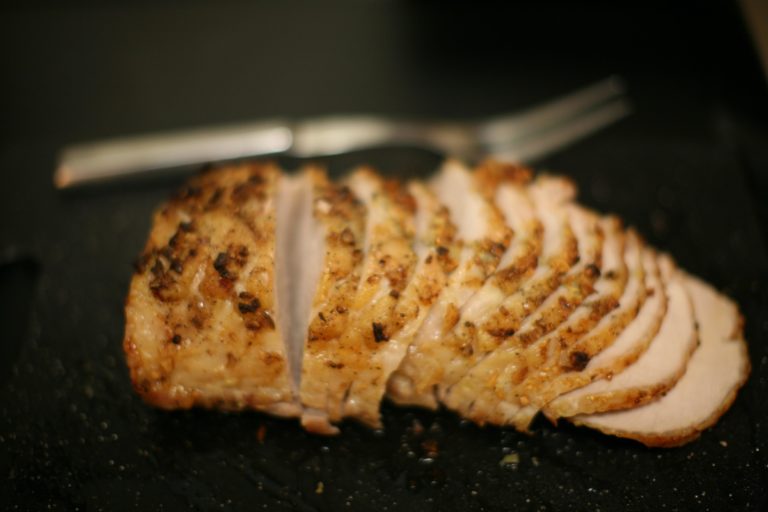
Chef's notes:
When we roast pork, all too often the pork is overcooked and ends up dry. This comes from the common belief that pork must be cooked to the ridiculous temperature of 160 degrees F. When the FDA came up with that temperature, the trichina worm was very prevalent in the pig industry. These days there is almost no risk of getting trichinosis from American pork. And cooking meat to 150 is more than sufficient to kill any parasites or bacteria present in the meat. A fair warning though—the trichina worm can still be found in some wild game and in developing countries.
There are many cuts of pork that can be roasted. For this article I chose one of the most common: pork loin. Pork loin is from the back of the pig, near the vertebrae, just above the ribs.
Ingredients
- 2-3 # of pork loin
- Sea salt
- Minced garlic
- Black pepper
- Onion slices
Roast Pork Loin with Sea Salt, Fresh-Cracked Black Pepper, Garlic, and Onion Slices
- Preheat the oven to 500 degrees F and prep the roast. The oven will take at least 20 minutes to heat up, so make sure to plan accordingly. Pork loin has a thick layer of fat on one side. In order to render that fat and achieve a crispy crust, score the top in a criss-cross pattern. Cut through the fat but try not to cut the meat too much. Apply the salt, spices, and seasonings to the roast and rub it in. For this recipe, I used sea salt, black pepper, and garlic. I also chopped some onion to roast the pork with; the onions will get caramelized and will taste awesome. Once the oven has preheated, place the roast on the rack in the next to the bottom position.
- The first stage of roasting pork is a high temperature for 20 or 30 minutes to render the fat and create a crust. In this first step of roasting pork, the high heat is melting down the fat or rendering it. The fat begins to get crispy and caramelize. This texture and flavor combination will be a nice contrast to the juicy and soft inside of the pork roast. Some people believe this step seals in juices. This is not true. Juices can escape just as easily after searing the outside. The only reason we brown the outside is because it looks nice and tastes good. The juices won’t go anywhere unless you overcook it or cut the roast while it’s too hot.
- The second stage of roasting pork will require patience and a digital thermometer. Once the roast has been in the oven long enough to get brown on the outside take the roast out of the oven and lower the temperature to 350 degrees F. The roasting time for this second stage will depend on the internal temperature of the roast, as when it reaches 150 F, it is done. The easiest way to monitor the internal temperature of the roast is to use a digital thermometer with a detachable probe. That way you can see the temperature rise as the roast finishes cooking. Many of these thermometers come with temperature alarms that will go off at a set temperature, like 150. Then you simply take the roast out. Pretty sweet.
- The final stage of roasting pork is letting the meat rest after coming out of the oven. Once the internal temperature has reached 150, take the roast out of the oven. Remove the roast from the pan or elevate it somehow to give the juices a place to go. Drape some aluminum foil over the top, set a timer for 20 minutes and walk away. This is very important. Let it sit for 20–30 minutes before cutting into it. Cut into it too soon and you ruin all your hard work. Trust me; it will be worth it. And don’t forget the onions you cooked alongside the roast. They will taste awesome with the pork, so serve them too.
Tips & Tricks
- You can finish the pork roast at 500 degrees if you want it done quicker. The inside will be a lot dryer, though, because the very middle must still achieve 150 degrees to be safe to eat. For really juicy pork roasts, you can slow roast it at 200 degrees. This method will take several hours, but the result may be worth the wait. Also, you can roast it for the duration at 350 degrees. And to get the crispy exterior, you can stick it under the broiler for a few minutes. There are a lot of ways to roast pork. Just don’t overcook it.
- Wait until the oven achieves the desired temperature before putting the roast in. Putting an oven thermometer on one of the racks is the best way to be sure. The oven thermostat may not be accurate.
- Don’t skip the resting step, as cutting into the meat while it is still very hot will dry it out.
- Check the temperature of the roast by placing the tip of the probe in the very center of the roast. Push it straight down from the top into the middle.
